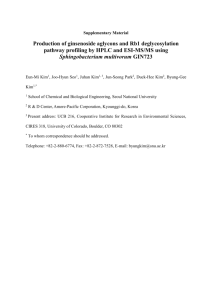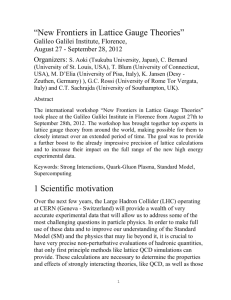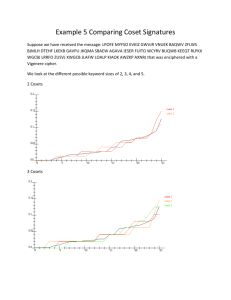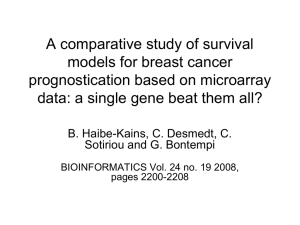A SHORT NOTE ON INDUCED REPRESENTATIONS FULVIO GESMUNDO
advertisement
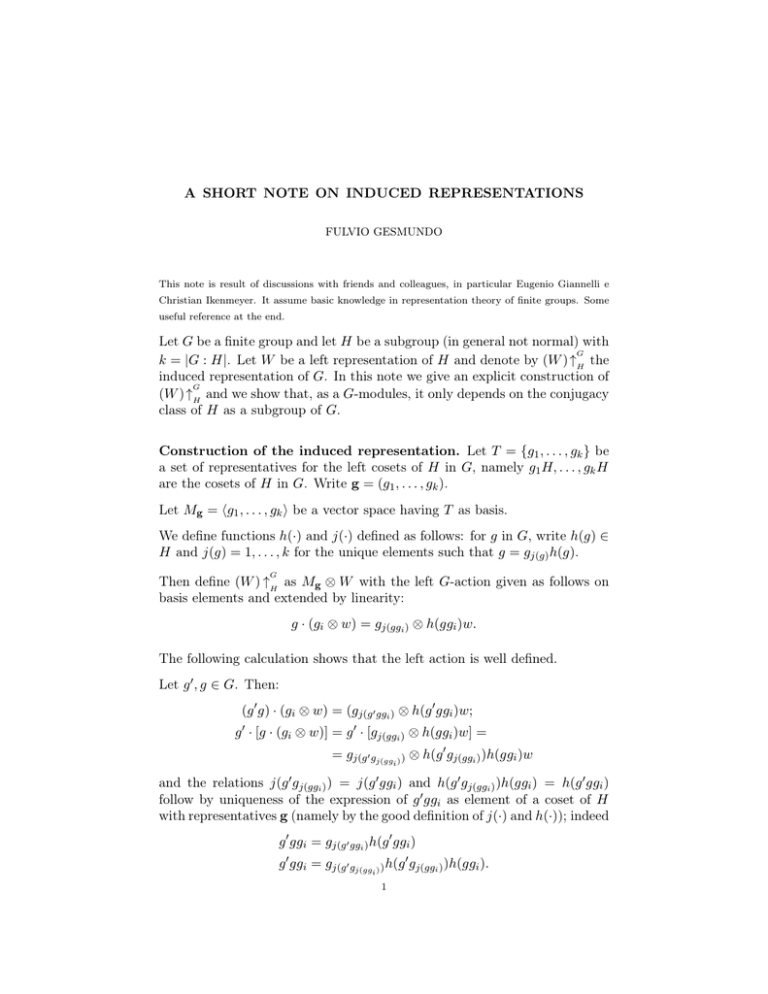
A SHORT NOTE ON INDUCED REPRESENTATIONS
FULVIO GESMUNDO
This note is result of discussions with friends and colleagues, in particular Eugenio Giannelli e
Christian Ikenmeyer. It assume basic knowledge in representation theory of finite groups. Some
useful reference at the end.
Let G be a finite group and let H be a subgroup (in general not normal) with
G
k = |G : H|. Let W be a left representation of H and denote by (W ) ↑H the
induced representation of G. In this note we give an explicit construction of
G
(W ) ↑H and we show that, as a G-modules, it only depends on the conjugacy
class of H as a subgroup of G.
Construction of the induced representation. Let T = {g1 , . . . , gk } be
a set of representatives for the left cosets of H in G, namely g1 H, . . . , gk H
are the cosets of H in G. Write g = (g1 , . . . , gk ).
Let Mg = hg1 , . . . , gk i be a vector space having T as basis.
We define functions h(·) and j(·) defined as follows: for g in G, write h(g) ∈
H and j(g) = 1, . . . , k for the unique elements such that g = gj(g) h(g).
G
Then define (W ) ↑H as Mg ⊗ W with the left G-action given as follows on
basis elements and extended by linearity:
g · (gi ⊗ w) = gj(ggi ) ⊗ h(ggi )w.
The following calculation shows that the left action is well defined.
Let g 0 , g ∈ G. Then:
(g 0 g) · (gi ⊗ w) = (gj(g0 ggi ) ⊗ h(g 0 ggi )w;
g 0 · [g · (gi ⊗ w)] = g 0 · [gj(ggi ) ⊗ h(ggi )w] =
= gj(g0 gj(gg ) ) ⊗ h(g 0 gj(ggi ) )h(ggi )w
i
j(g 0 gj(ggi ) )
j(g 0 ggi )
and the relations
=
and h(g 0 gj(ggi ) )h(ggi ) = h(g 0 ggi )
follow by uniqueness of the expression of g 0 ggi as element of a coset of H
with representatives g (namely by the good definition of j(·) and h(·)); indeed
g 0 ggi = gj(g0 ggi ) h(g 0 ggi )
g 0 ggi = gj(g0 gj(gg ) ) h(g 0 gj(ggi ) )h(ggi ).
i
1
2
FULVIO GESMUNDO
Notice that changing set of representatives provides an isomorphic representation. Let g0 = (g10 , . . . , gk0 ), with gi H = gj0 H. The two realizations Mg ⊗ W
G
and Mg0 ⊗ W of (W ) ↑H are isomorphic via the map defines as follows: let
hi ∈ H such that gi = gi0 ki ; then define
ϕ : M g ⊗ W → Mg 0 ⊗ W
gi ⊗ w 7→ gi0 ⊗ ki w.
The map ϕ is a G-equivariant isomorphism. Write j 0 (·) and h0 (·) for functions
analogous to j(·) and h(·), calculated with respect to g0 . The following
calculation checks equivariancy:
0
ϕ(g · (gi ⊗ w)) = ϕ(gj(ggi ) ⊗ h(ggi )w) = gj(gg
⊗ kj(ggi ) h(ggi )w;
i)
g · ϕ(gi ⊗ w) = g · (gi0 ⊗ ki w) = gj0 0 (gg0 ) ⊗ h0 (ggi0 )ki w.
i
j 0 (ggi0 )
The two relations
= j(ggi ) and kj(ggi ) h(ggi ) = h0 (ggi0 )ki follow from
the uniqueness of the expression of the element ggi in a coset of H with
representatives g; indeed we have
ggi = ggi0 ki = gj0 0 (gg0 ) h0 (ggi0 )ki ,
i
0
ggi = gj(ggi ) h(ggi ) = gj(gg
k
h(ggi ),
i ) j(ggi )
0
so gj0 0 (gg0 ) = gj(gg
and h0 (ggi0 )ki = kj(ggi ) h(ggi ).
i)
i
e is a conjugate of H in G,
Conjugate subgroups. Now suppose that H
−1
e = τ Hτ or equivalently Hτ = τ H.
e
namely there exists τ ∈ G such that H
The isomorphism
e →H
ψτ : H
e
h 7→ τ e
hτ −1
e via e
f
makes W into a left module for H
h · w = ψτ (e
h) · w. We denote by W
this representation.
f ) ↑G ' (W ) ↑G as G-representations.
We want to show that (W
H
e
H
e = (e
Define g
g1 , . . . , gek ) to be the set of representatives for the left cosets of
e
e define a set of
H defined by gei = gi τ . It is immediate that the elements of g
e = gej H,
e if and only if gi τ H
e = gj τ H
e if and only
representatives: indeed gei H
if gi Hτ = gj Hτ if and only if gi H = gj H if and only if i = j.
Write e
h(·) and e
j(·) for functions analogous to h(·) and j(·) relative to cosets
e
of H with representatives g.
f.
f ) ↑G = Mge ⊗ W
We have a realization (W
e
H
A SHORT NOTE ON INDUCED REPRESENTATIONS
3
Define
f → Mg ⊗ W
T : Mge ⊗ W
gei ⊗ w 7→ gi ⊗ w.
The map T defines an isomorphism of vector spaces. We show that it is
G-equivariant. Let g ∈ G. We have
T (g · (e
gi ⊗ w)) = T (e
ge
⊗e
h(ge
gi )w) =
j(ge
gi )
= T (e
gej(gegi ) ⊗ ϕτ (e
h(ge
gi ))w) = gej(gegi ) ⊗ τ e
h(ge
gi )τ −1 w,
g · T (e
gi ⊗ w) = g · (gi ⊗ w) = gj(ggi ) ⊗ h(ggi )w;
to prove equivariancy, we need to show
j(ggi ) = e
j(ge
gi )
h(ggi ) = τ e
h(ge
gi )τ −1 .
We consider the element ge
gi τ −1 . We have
ge
gi τ −1 = ggi τ τ −1 = ggi ,
ge
gi τ −1 = geej(gegi )e
h(ge
gi )τ −1 = gej(gegi ) τ e
h(ge
gi )τ −1 ,
and this leads to the conclusion we are seeking as τ e
h(ge
gi )τ −1 is an element
G
G
f ) ↑ ' (W ) ↑ as G-representations.
of H. This shows that (W
H
e
H
References
[A]
J.L. Alperin Local Representation Theory, Cambridge Studies in Advanced Mathematics, vol. 11, Cambridge University Press, 1986.
[FH] W. Fulton and J. Harris Representation theory: a first course, Graduate Texts in
Mathematics, vol. 129, Springer-Verlag, New York, 1991.
[JK] G.D. James, A. Kerber The Representation Theory of the Symmetric Group,
Addison-Wesley, London, 1980.
[R]
M. Reeder Notes on Representation Theory, Lecture Notes available at
https://www2.bc.edu/˜reederma/RepThy.pdf, 2014.
E-mail address: fulges@math.tamu.edu
Department of Mathematics - Texas A&M University - College Station - TX
- 77840


